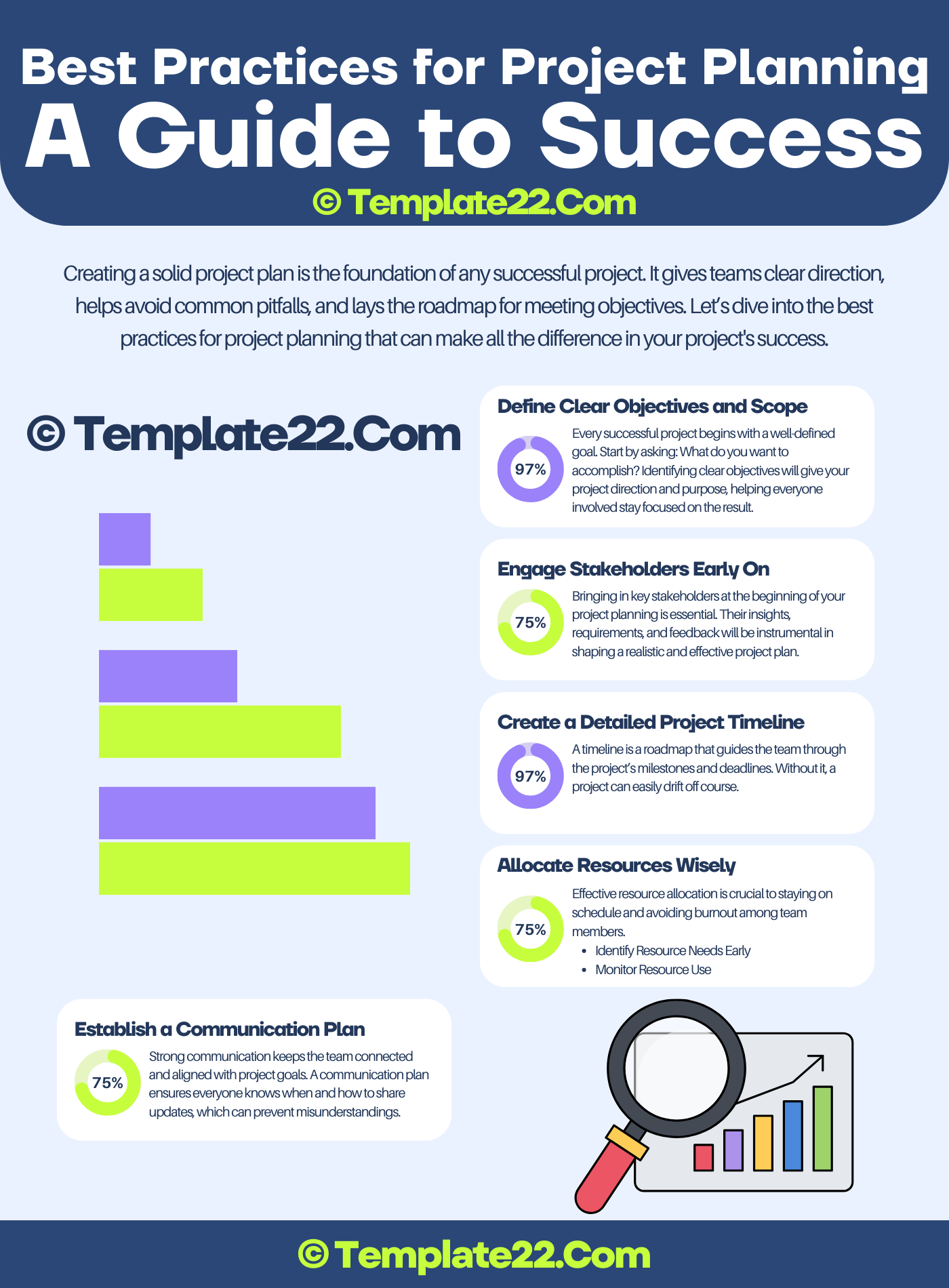 Creating a solid project plan is the foundation of any successful project. It gives teams clear direction, helps avoid common pitfalls, and lays the roadmap for meeting objectives. Let’s dive into the best practices for project planning that can make all the difference in your project’s success.
Creating a solid project plan is the foundation of any successful project. It gives teams clear direction, helps avoid common pitfalls, and lays the roadmap for meeting objectives. Let’s dive into the best practices for project planning that can make all the difference in your project’s success.
1. Define Clear Objectives and Scope
Every successful project begins with a well-defined goal. Start by asking: What do you want to accomplish? Identifying clear objectives will give your project direction and purpose, helping everyone involved stay focused on the result.
- Set Specific Goals: Use the SMART criteria—Specific, Measurable, Achievable, Relevant, and Time-bound. This framework ensures your goals are clear and attainable.
- Outline Project Scope: Defining the scope will help avoid “scope creep,” which occurs when new tasks or deliverables are added without proper approval. Scope creep can easily derail a project by overstretching resources or timelines.
2. Engage Stakeholders Early On
Bringing in key stakeholders at the beginning of your project planning is essential. Their insights, requirements, and feedback will be instrumental in shaping a realistic and effective project plan.
- Identify Key Stakeholders: Individuals or groups with a vested interest in the project, such as clients, senior management, or team leads.
- Gather Requirements and Expectations: Conduct interviews or workshops to understand their needs and concerns. This information will guide your planning and help you align the project objectives with stakeholder expectations.
CLICK HERE TO DOWNLOAD 300+ PROJECT MANAGEMENT TEMPLATES & DOCUMENTS IN EXCEL
3. Create a Detailed Project Timeline
A timeline is a roadmap that guides the team through the project’s milestones and deadlines. Without it, a project can easily drift off course.
- Break Down the Project into Phases: Divide the project into manageable phases, each with specific deliverables and timelines.
- Set Milestones: Milestones are key points along the project timeline that signify the completion of important stages. Setting these helps keep the team motivated and provides checkpoints for progress.
- Use Visual Aids: Gantt charts or flow diagrams can offer visual clarity, helping everyone understand the project flow and timeline.
4. Allocate Resources Wisely
Effective resource allocation is crucial to staying on schedule and avoiding burnout among team members.
- Identify Resource Needs Early: Based on the project scope, determine the necessary human and material resources. These could include specialized team members, equipment, software, or budget allocations.
- Monitor Resource Use: Regularly track resource usage throughout the project to ensure you’re on budget and meeting deadlines. If there are any shortfalls, address them promptly to avoid bottlenecks.
5. Establish a Communication Plan
Strong communication keeps the team connected and aligned with project goals. A communication plan ensures everyone knows when and how to share updates, which can prevent misunderstandings.
- Choose Communication Channels: Decide which tools you’ll use for different types of communication. For instance, Slack for daily check-ins, email for formal updates, and project management software for task tracking.
- Set a Meeting Schedule: Regular check-ins, such as weekly or bi-weekly meetings, can help the team address issues in real time and keep everyone in the loop on progress and challenges.
6. Risk Management: Plan for the Unexpected
Projects rarely go exactly as planned. Identifying potential risks and planning for them can save you from major setbacks.
- Identify Potential Risks: Common risks include resource shortages, timeline delays, and changing project requirements. Think through what might go wrong and how it would impact the project.
- Create a Contingency Plan: For each identified risk, have a backup plan ready. This could mean securing additional resources or setting aside a buffer in the budget.
7. Utilize Project Management Tools
Project management tools like Asana, Trello, and Microsoft Project can greatly streamline the planning and execution process.
- Task Tracking: These tools allow you to assign tasks, set deadlines, and monitor progress in real time.
- Team Collaboration: Most project management tools come with communication features, helping teams collaborate easily and share updates.
CLICK HERE TO DOWNLOAD 300+ PROJECT MANAGEMENT TEMPLATES & DOCUMENTS IN EXCEL
8. Regularly Review and Adjust the Plan
Project planning isn’t a one-time task. It requires continuous monitoring and flexibility.
- Set Up Review Points: Regularly check in on project progress and evaluate if adjustments are necessary. Sometimes, priorities shift, or unforeseen challenges arise that require you to modify the plan.
- Be Open to Changes: Adaptability is key. Projects evolve, and being open to changes will help you stay on track rather than sticking rigidly to an outdated plan.
Wrapping Up
A well-structured project plan doesn’t just serve as a guide—it’s a powerful tool that drives project success. By following these best practices, you can set a strong foundation, navigate challenges effectively, and lead your team toward achieving project goals with confidence.
Whether it’s a large-scale project or a smaller initiative, these steps can help ensure you’re prepared, proactive, and ready to succeed.



